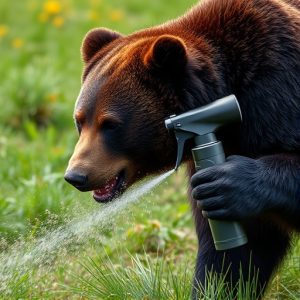Bear Attack Protection: Spray, Understanding, and Safety Measures for Survival
Understanding bear behavior and carrying bear spray, as outlined by the Bear Spray Testing Safety Gu…….
Understanding bear behavior and carrying bear spray, as outlined by the Bear Spray Testing Safety Guidelines, is crucial for safety in wild areas. Making noise while hiking can deter bears that rely on their strong sense of smell. Bear spray acts as a barrier, disorienting bears temporarily to allow escape. Regular testing and understanding usage distance are key practices; users should practice aim and awareness, implementing security measures during outdoor adventures to enhance safety.
In the vast wilderness, understanding bear behavior is key to your survival. This article equips you with essential knowledge on navigating and protecting yourself from potential bear attacks. We delve into the science behind bear attack patterns, exploring factors that trigger aggression. Bear spray emerges as a powerful tool, with practical tips on testing and application techniques for optimal safety. Additionally, discover other critical safety measures beyond bear spray to enhance your wilderness survival skills, guided by expert guidelines.
- Understanding Bear Behavior and Their Attack Patterns
- Bear Spray: An Effective Deterrent – Testing and Application Techniques
- Additional Safety Measures: Beyond Bear Spray for Wilderness Survival
Understanding Bear Behavior and Their Attack Patterns
Understanding bear behavior is crucial for anyone venturing into wild environments. Different species exhibit unique patterns, with grizzly bears and black bears having distinct attack behaviors. Knowing their habits can help hikers and campers avoid dangerous encounters. Generally, bears are shy animals that prefer to avoid humans, only attacking when they feel threatened or surprised. They often use their powerful sense of smell to detect food sources, so making noise while hiking in bear country can deter them.
When it comes to protection from bear attacks, one effective measure is carrying and knowing how to use bear spray. Bear Spray Testing Safety Guidelines recommend proper training and practice to ensure its effectiveness. This pepper-based spray creates a barrier of irritants, temporarily disorienting the bear and giving you time to escape. Regular testing and understanding the recommended usage distance are essential safety practices for anyone at risk of bear encounters.
Bear Spray: An Effective Deterrent – Testing and Application Techniques
Bear spray is a popular and effective deterrent for protecting against bear attacks in the wilderness. It’s important to understand that while it can be a game-changer in potentially dangerous situations, proper usage and testing are crucial for its effectiveness. When it comes to bear spray testing safety guidelines, users should always follow recommended procedures. This includes conducting practice tests in controlled environments to familiarize oneself with the spray pattern, range, and duration of protection.
The application technique is key; aim for the bear’s face and eyes as this area is highly sensitive. Many experts suggest a ‘Y’ shape when spraying, covering both sides of the body and the face. It’s recommended to test the spray’s reach by practicing in an open space before heading into potential bear country. Regular testing ensures users are prepared and confident in their ability to use bear spray effectively if needed, enhancing overall safety guidelines during outdoor adventures.
Additional Safety Measures: Beyond Bear Spray for Wilderness Survival
In addition to carrying bear spray, a vital tool for defense against unexpected encounters, wilderness survivors should familiarize themselves with comprehensive safety guidelines. These go beyond mere spraying and include understanding bear behavior, awareness during hikes, and proper food storage practices. Regular training sessions that simulate real-life scenarios can better prepare individuals on how to respond when faced with an aggressive bear.
Bear spray testing involves practical exercises designed to refine one’s technique. It encourages users to understand the reach of their spray and practice aiming accurately under stressful conditions. Adhering to safety guidelines during these tests is crucial, ensuring that individuals maintain a safe distance from simulated bears while evaluating the effectiveness of their protective measures.
In conclusion, understanding bear behavior and employing effective protection methods like bear spray testing and proper application are crucial for wilderness survival. While no single measure guarantees 100% safety, a combination of awareness, preparation, and adherence to safety guidelines can significantly reduce the risk of bear attacks. Always stay informed, practice responsible wilderness conduct, and prioritize your safety in bear country.


